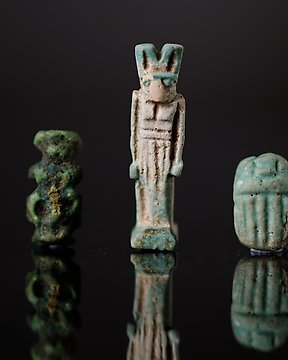
Oud-Egyptisch Egyptische goden Anubis, Bes en scarabee-amulet - 4 cm
Nr. 85038265

Nr. 85038265

A fine Ancient Egyptian poppy seed amulet carved from lapis lazuli, featuring a pyriform body with a flat, circular base that tapers to a thin tip. The deep blue semi-precious stone is banded with contrasting white and golden brown striations, creating a polychrome effect. The tip is perforated for suspension. The amulet is in excellent overall condition.
The Egyptians wore amulets alongside other pieces of jewellery. They were decorative, but also served a practical purpose, being considered to bestow power and protection upon the wearer. Many of the amulets have been found inside the wrappings of mummies, as they were used to prepare the deceased for the afterlife. Lapis lazuli stone was highly regarded in Mesopotamia and the Near East in general. Rulers and members of the elite had the custom of being buried with ornaments made partly or entirely of this semi-precious stone.
Poppy or thistle amulets were representative of healing and the removal of pain. Thistles were common all over Egypt, but especially around the Nile. It is thought that they were peeled and boiled before consumption, with the thistle used in some parts of the world as a herbal treatment for hepatic disorders. If, on the other hand, the amulet is intended to represent a poppy, the piece retains symbolic significance. Indeed, there is evidence for the extraction of morphine from poppies in the ancient world.
Measurements: W 0.5cm x H 1.5cm
Provenance: From a UK collection, 1920's-1940's
Zo koop je op Catawiki
1. Ontdek iets bijzonders
2. Plaats het hoogste bod
3. Veilig betalen